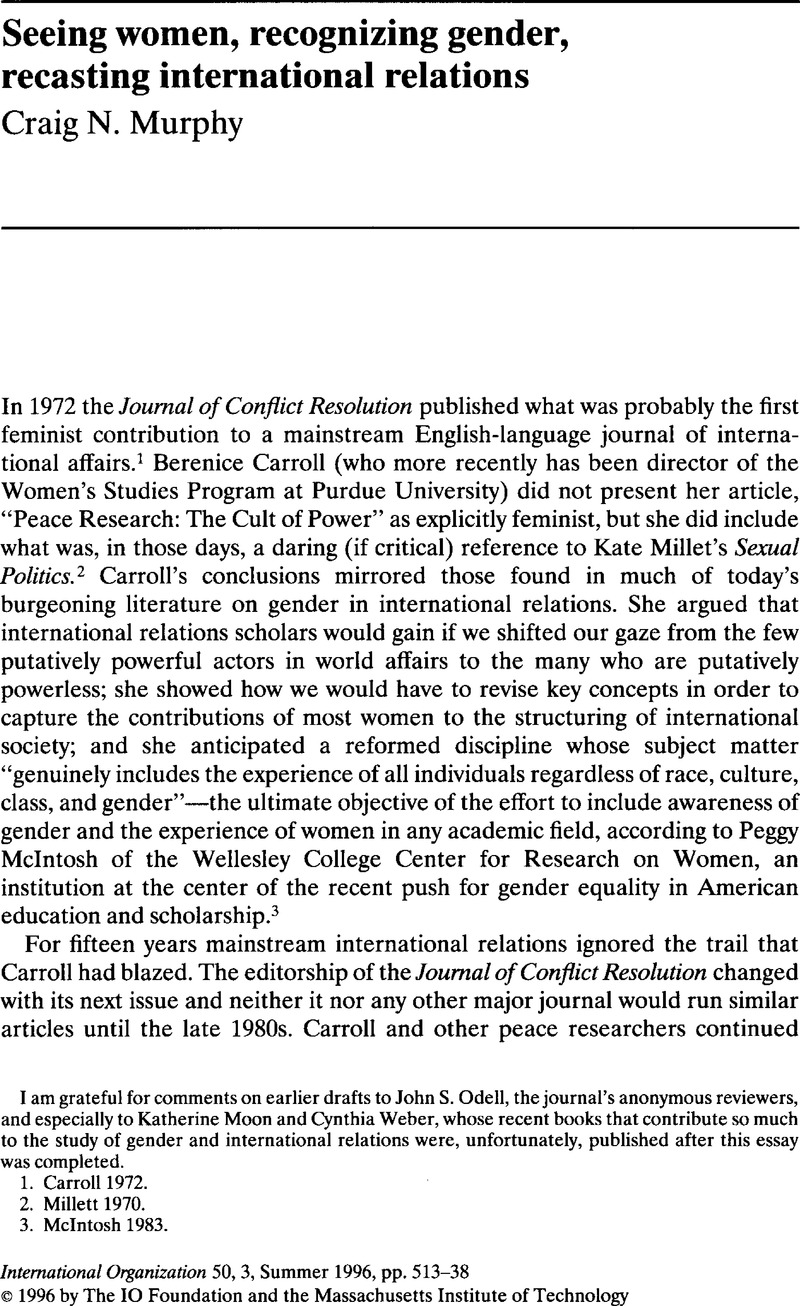Crossref Citations
This article has been cited by the following publications. This list is generated based on data provided by Crossref.
WEBER, CYNTHIA
1999.
IR: The Resurrection.
European Journal of International Relations,
Vol. 5,
Issue. 4,
p.
435.
Leander, Anna
1999.
Individualism and World Politics.
p.
89.
Morton, Adam David
2000.
Globalization and the Politics of Resistance.
p.
255.
Steans, Jill
2003.
Engaging from the Margins: Feminist Encounters with the ‘Mainstream’ of International Relations.
The British Journal of Politics and International Relations,
Vol. 5,
Issue. 3,
p.
428.
2003.
Book Reviews.
Children & Society,
Vol. 17,
Issue. 4,
p.
330.
Blanchard, Eric M.
2003.
Gender, International Relations, and the Development of Feminist Security Theory.
Signs: Journal of Women in Culture and Society,
Vol. 28,
Issue. 4,
p.
1289.
Feldheim, Mary Ann
2003.
Mary parker follett lost and found - again, and again, and again.
International Journal of Organization Theory & Behavior,
Vol. 7,
Issue. 3,
p.
341.
Beckwith, Karen
2005.
A Common Language of Gender?.
Politics & Gender,
Vol. 1,
Issue. 01,
Ann Feldheim, Mary
2005.
Handbook of Organization Theory and Management.
Vol. 20056438,
Issue. ,
Elias, Juanita
2008.
Introduction.
Men and Masculinities,
Vol. 10,
Issue. 4,
p.
383.
Elias, Juanita
and
Beasley, Christine
2009.
Hegemonic Masculinity and Globalization: ‘Transnational Business Masculinities’ and Beyond.
Globalizations,
Vol. 6,
Issue. 2,
p.
281.
Koschut, Simon
2013.
Sicherheitspolitische Identität in den Internationalen Beziehungen: konzeptionelle Überlegungen und empirische Praxis.
Zeitschrift für Außen- und Sicherheitspolitik,
Vol. 6,
Issue. 1,
p.
53.
Harman, Sophie
2014.
The Handbook of Global Health Policy.
p.
47.
Shields, Stuart
and
Wallin, Sara
2015.
The European Bank for Reconstruction and Development's Gender Action Plan and the Gendered Political Economy of Post-Communist Transition.
Globalizations,
Vol. 12,
Issue. 3,
p.
383.
Pearson, Elizabeth
2016.
The Case of Roshonara Choudhry: Implications for Theory on Online Radicalization, ISIS Women, and the Gendered Jihad.
Policy & Internet,
Vol. 8,
Issue. 1,
p.
5.
Huber, Valeska
Pietsch, Tamson
and
Rietzler, Katharina
2021.
Women's International Thought and the New Professions, 1900–1940.
Modern Intellectual History,
Vol. 18,
Issue. 1,
p.
121.
Sondarjee, Maïka
2022.
We Are a Community of Practice, Not a Paradigm! How to Meaningfully Integrate Gender and Feminist Approaches in IR Syllabi.
International Studies Perspectives,
Vol. 23,
Issue. 3,
p.
229.
Gök, Gonca Oğuz
and
Gök, Mehmet Şahin
2023.
An Empirical Assessment of Gender Inequality in Human Development: Evidence from G20 Countries.
Society,
Vol. 60,
Issue. 4,
p.
566.
Andrabi, Shazana
2023.
South Asian Women and International Relations.
p.
33.
Ojha, Abhiruchi
and
Jaiswal, Pramod
2023.
South Asian Women and International Relations.
p.
1.



